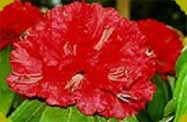|
Aconitum heterophyllum
Wall. ex. Royle

|
Species |
Aconitum heterophyllum
Wall. ex. Royle |
|
Local Name |
Bikh, Atish (Nep) |
|
Synonym |
A.palmatum
D.Don |
|
Family |
Ranunculaceae |
|
Habitat |
A herb 0.3-1.2 m tall. Grown in open grassy slopes and
Rhododendron shrubs of sub alpine and alpine Himalaya. |
|
Distribution |
Distributed in sub- alpine and alpine Himalaya between
2,750- 3700 m and also from Indus to Kumoan at the
height of 6000- 15000 ft. |
|
Sikkim |
Memenchu Lake, Tamjay, Kyongnosla, Thangu, Green Lake
Dzongri, Nathang, Lachung, and Lachen. |
|
Out side |
Jammu and Kashmir (Gulmarg, Pirpass, Amarnath, Sarbal,
Dagwan, Tilail range, Panikher, Zozilla, Ladakh, Darra,
Baramula, Sonamarg, Chor, Srinagar); Himachal Pradesh (Kangra
valley, Hoksar, Kyelong, Tucharpass, Chitkul, Dalhousie,
Chamba, Sirmous, Simla Aharkunda, Narkanda, Sissu, Chat,
Fagu, Kulu, Lahul- spiti); Uttar Pradesh (Surya Kund,
Koshkalyan, Kedarnath, Rishiganga Valley, Birodh,
Khatting, Kalyani, Bhojbara, Kultinangte Valley, Luai,
Deeban, Chakrata Pindari, Milam, Amritganga) also
distributed in Pakistan and Iran. |
|
General |
|
|
Morphological |
A herb 0.3 - 1.2 m tall. Roots
biennial tuberous, paired, whitish or green. Leaves
ovate- cordate to rounded, the upper ones clasp the
stem. Lowest leaves deeply lobed and long stalked.
Flowers bright blue usually in lax spike like cluster
with very variable bracts greenish purple conspicuously
dark veined. Follicles 5, 16- 8 mm long, shortly hairy
erect. Seeds obpyramidal, blackish brown. |
|
Flowering |
August-October |
|
Fruiting |
September-November |
|
History |
|
|
Parts |
Underground roots and stems |
|
Status |
Critically endangered |
|
Phytochemistry |
Roots of the plant yield several
alkaloids- heterophyllisine, heterophylline and
heterophyllidin [4]; heteratisine, atisine, atidine, F-
dihydroatisine, isolatisine, hestisine, hetidine and
hetisinone have also been isolated [5]. |
|
Agrocultivation |
It thrives well in cool climate and a
well- drained loamy soil. Propagation is done either by
divisions of roots or from seeds. If the roots are used
for propagation then the roots are dug up after the
stems have died down. The larger ones are used for drugs
whereas smaller ones are used for propagation. If the
seeds are used for propagation, they should be sown soon
after harvesting. Plants have been obtained via somatic
embryogenesis in Calli derived from in vitro raised leaf
and petiole explants of A. heterophyllum (through Tissue
culture). Complete plantlets are formed after 4 weeks
and are transferred to the field. |
|
Reference |
1. Kumar, Sushi [, Janardan Singh,
N.C. Shah, Vinay Ranjan (1997). Indian Medicinal and
Aromatic plants facing Genetic Erosion. Central
Institute of Medicinal and Aromatic Plants. Lucknow 33-
35.
2. Thakur, R.S., H.S. Puri, Akhtar
Hussain (1989). Major Medicinal Plants of India. Central
Institute of Medicinal and Aromatic Plants Lucknow. 28-
30.
3. Singh, Janardan, Ashok Sharma,
Subhash Chandra Singh, Sushil Kumar (1999). Medicinal
Plants for Bioprospection (Vol. 1). Central Institute of
Medicinal and Aromatic Plants, Lucknow. 39- 41.
4. Anonymous. (1985) The Wealth of
India (Vol.1 A). Publications and Informations.
Directorate CSIR, New Delhi. 61- 62.
5. Chatterjee, Asima, Satyesh Chandra
Pakrashi (1997). The Treatise of Indian Medicinal Plants
(Vol. 1). Publications and Information Directorate, New
Delhi. 111- 112.
6. Tsarong, J. Tseuang (1994).
Tibetan Medicinal Plants. Tibetan Medicinal
Publications, Kalimpong (W.B), India. 15.
7. Progress Report of the Project
"Studies on Medicinal Plants of Sikkim" (1998- 2001).
State Council of Science and Technology for Sikkim. |
|
Medicinal |
|
|
Ayurvedic |
The root forms an ingredient of a number of Ayurvedic
formulations. Balchaturbhadra churna, Astivisachurna
(fever and stomach troubles) Amritarishta, Chandraprabha
Vati, Yograj Guggulu, Mahasudarsana Churn (in
arthritis). |
|
Unani |
The roots are used as an astringent
in bleeding piles, amenorrhea and leucorrhoea and are an
ingredient of Sufuf Babis, Majun Bawasir, Majun Jograj
Guggulu and Majun Murrawahul-Arwah. |
|
Traditional |
Half of 2 gm fine powder is given as
bitter tonic in diarrhoea and mal-absorption syndrome.
Two and half of 6 gm powder may be given in case of
fever in divided dose. |
|
Others |
The tuberous roots are very much used in various
ailments such as stomachache, bilious complaints,
intermittent fevers, diarrhoea, dysentery, acute
inflammatory infections, antiperiodic, aphrodisiac and
as bitter tonic. |
|
Prepartation |
|
|
Picture |
|
|
|
|
|

Rhododendron


Amongst the many
floral treaties of Sikkim Himalaya one of the earliest ones may be
found over the genus Rhododendron (Gk. rhodo = red, dendrons = tree
). |
| |
|
|
|

Orchid


Orchid
known for their brilliance in colors, unusual shapes
attractive growth habits, variety in fragrance and
exquisite beauty can attract any nature lovers.
|
| |
|
|
|

Medicinal Plant


Sikkim
with its total geographical area of 7,096 sq km is
bestowed with a huge diversity of flora and fauna.
|
| |
|
|
|
|
|